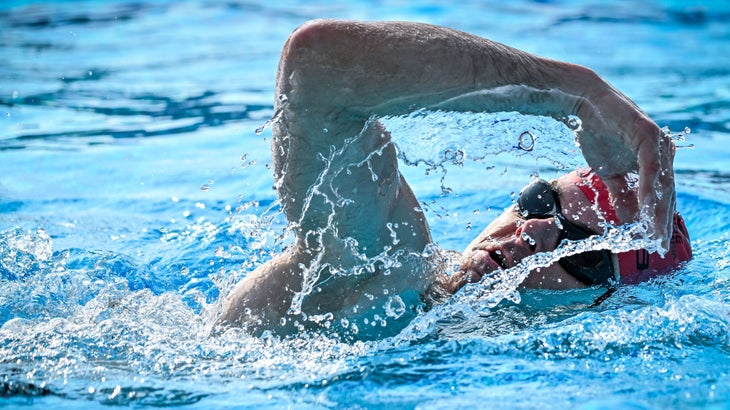New perk! Get after it with local recommendations just for you. Discover nearby events, routes out your door, and hidden gems when you sign up for the Local Running Drop.
A huge part of swimming fast is swimming well. If you’re motivated to improve your swim leg, you’ve probably been working on your swimming skills. Hopefully, you’ve identified some limitations in your stroke, and you’ve implemented specific swim drills or skill-development activities to improve your swimming. If you’ve picked good drills, you’ve probably seen a lot of progress, which is really exciting.
But now it’s been several months, and that initial excitement has probably started to fade. You might feel like you’re not making progress. Here’s the reality. Even the best drills eventually stop working. They’re no longer stimulating, they’re no longer engaging, and they no longer promote learning. It’s just like training. If you perform the same distances for the same speeds without any progression, there’s no adaptation.
To continue improving your swimming skills, something has to change. The common mistake is to change the drills. If you want to improve your skills as much as possible, you want to use the best drills possible. It doesn’t make sense to use less-effective drills.
Instead of changing the drills, change how they’re performed. Fortunately, there are a lot of ways to change how any drill is performed. These changes provide novel challenges that will help you reengage with the drills you already know work and challenge you to perform your drills with even more skill.
New ways to use staple swim drills

Each of these strategies provides novelty and challenges your skills in some way. Within each of these categories, there are a lot of different options – far too many to mention here. Don’t limit yourself.
Add speed
Add speed to the drills. You can simply swim at faster speeds, you can descend your speed so that each repetition is faster, or you can build from slow to fast within a repetition. The faster the speed, the more the challenge, meaning you can continue to increase the challenge over time.
Add training aids
By using different training aids, such as fins, paddles, pull buoys, or snorkels, you’ll change how the drill is performed. Each of these aids creates a different impact and presents a different challenge.
Add resistance
Adding resistance will require you to be more effective at creating propulsion, regardless of the drill you’re using. More resistance means you’ll have to create more propulsion.
Add hand postures
The hands are really important in swimming. By closing them or holding them in different positions (for example, making an “O.K.” sign), you’re forcing yourself to use your forearm instead of just your hand. When you open your hand back up, you’ll be able to use both.
Add fatigue
Performing drills with fatigue will help you learn how to execute your skills when you’re tired, which is exactly what happens in races. Adding fatigue also forces you to find the most efficient way to execute the drill. More fatigue, more challenge.
Add stroke counts or stroke rates
Changing your stroke count or your stroke rate will require you to change the execution of the drill. Lower stroke counts and slower stroke rates will force you to take your time between strokes, building efficiency. Higher stroke counts and faster stroke rates will force you to execute the drill with more precision. These options are great because they force you to change. You’ll want to use a tempo trainer when implementing stroke rates.
Combine strategies
These strategies don’t have to be used separately. They can be combined. You can use a pull buoy and a parachute. Or you can use a stroke count with a hand posture. By combining different strategies, you can create a lot more options, and you can create more targeted interventions.
Putting it into practice
Let’s take two drills, Paddle Cap Freestyle and Underwater Recovery. I’ll start off with a very basic set and then add different progressions that challenge the drills. Keep in mind that while we’re using two drills here, you can apply these same concepts to any drill you’d like. As mentioned above, there are almost limitless ways to create a challenge, and the examples are just a sample of what’s possible.
Paddle cap freestyle drill
8×25 paddle cap freestyle
8×25 paddle cap freestyle; descend 1-4/5-8
8×25 paddle cap freestyle; ODD closed fist EVEN open hand
8×25 paddle cap freestyle; solid effort; take only 5 seconds rest between repetitions
Underwater recovery drill
8×25 underwater recovery
8×25 underwater recovery; add pull buoy
8×25 underwater recovery; add a parachute
8×25 underwater recovery; take one less stroke 1-4/5-8
Each of these sets will present a unique challenge to your skills. Banish burnout by taking the drills you’re already doing and increasing the challenge to drive more engagement and more learning. A simple change is all that’s required.
